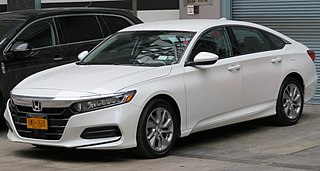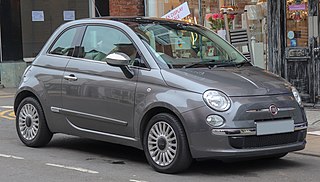
Minivan is a car classification for vehicles designed to transport passengers in the rear seating row(s), with reconfigurable seats in two or three rows. The equivalent classification in Europe is MPV or M-segment.

A sport utility vehicle (SUV) is a car classification that combines elements of road-going passenger cars with features from off-road vehicles, such as raised ground clearance and four-wheel drive.
A7, A.7, A 7, A07 or A-7 may refer to:
Governments and private organizations have developed car classification schemes that are used for various purposes including regulation, description, and categorization of cars.

Compact car is a vehicle size class—predominantly used in North America—that sits between subcompact cars and mid-size cars. "Small family car" is a British term and a part of the C-segment in the European car classification. However, before the downsizing of the United States car industry in the 1970s and 1980s, larger vehicles with wheelbases up to 110 in (2.79 m) were considered "compact cars" in the United States.

Subcompact car is a North American classification for cars smaller than a compact car. It is broadly equivalent to the B-segment (Europe), supermini or A0-class (China) classifications.
Vehicle size classes are series of ratings assigned to different segments of automotive vehicles for the purposes of vehicle emissions control and fuel economy calculation. Various methods are used to classify vehicles; in North America, passenger vehicles are classified by total interior capacity while trucks are classified by gross vehicle weight rating (GVWR). Vehicle segments in the European Union use linear measurements to describe size. Asian vehicle classifications are a combination of dimensions and engine displacement.

Mid-size—also known as intermediate—is a vehicle size class which originated in the United States and is used for cars larger than compact cars and smaller than full-size cars. "Large family car" is a UK term and a part of the D-segment in the European car classification. Mid-size cars are manufactured in a variety of body styles, including sedans, coupes, station wagons, hatchbacks, and convertibles. Compact executive cars can also fall under the mid-size category.

Full-size car—also known as large car—is a vehicle size class which originated in the United States and is used for cars larger than mid-size cars. It is the largest size class for cars. In Europe, it is known as E-segment or F-segment.

A 2+2 is a car-body style that has a seat each for the driver and front passenger, and two rear seats. The latter may be individual "bucket" seats, fold-downs, or a full-width "bucketed" bench seat, but always with less leg room than either the front or a standard 2-door car. The style is different from 4- or 5- seat automobiles having normal-size rear seats, with second-row 2+2 seating typically only suitable for children or occasional use.

Executive car is a British term for a large car which is equivalent to the European E-segment and American full-size classifications. Executive cars are larger than compact executive cars, and smaller than luxury saloons / full-size luxury sedans.
A car rental, hire car or car hire agency is a company that rents automobiles for short periods of time to the public, generally ranging from a few hours to a few weeks. It is often organized with numerous local branches, and primarily located near airports or busy city areas and often complemented by a website allowing online reservations.

A compact executive car, also known as a compact luxury car, is a premium car larger than a premium compact and smaller than an executive car. Compact executive car is a UK term and a part of the D-segment in the European car classification.
The term light car is used in Great Britain since the early part of the 20th century for an automobile less than 1.5 litres engine capacity. In modern car classification this term would be roughly equivalent to a subcompact car. There are numerous light car clubs in Britain and Australia.

The C-segment is the 3rd category of the European segments for passenger cars and is described as "medium cars". It is equivalent to the Euro NCAP "small family car" size class, and the compact car category in the United States.

A light commercial vehicle (LCV) in the European Union, Australia and New Zealand is a commercial carrier vehicle with a gross vehicle weight of no more than 3.5 metric tons (tonnes). The LCV designation is also occasionally used in both Canada and Ireland.

The E-segment is the 5th category of the European segments for passenger cars, synonymous with the term executive car.
Truck classifications are typically based upon the maximum loaded weight of the truck, typically using the gross vehicle weight rating (GVWR) and sometimes also the gross trailer weight rating (GTWR), and can vary among jurisdictions.

Excepting those of the Europe-wide safety assessment programme Euro NCAP, vehicle segments in Europe do not have formal characterization or regulations. Although the definition is vague, there is little overlap between segments A–F based on weight and size parameters.












